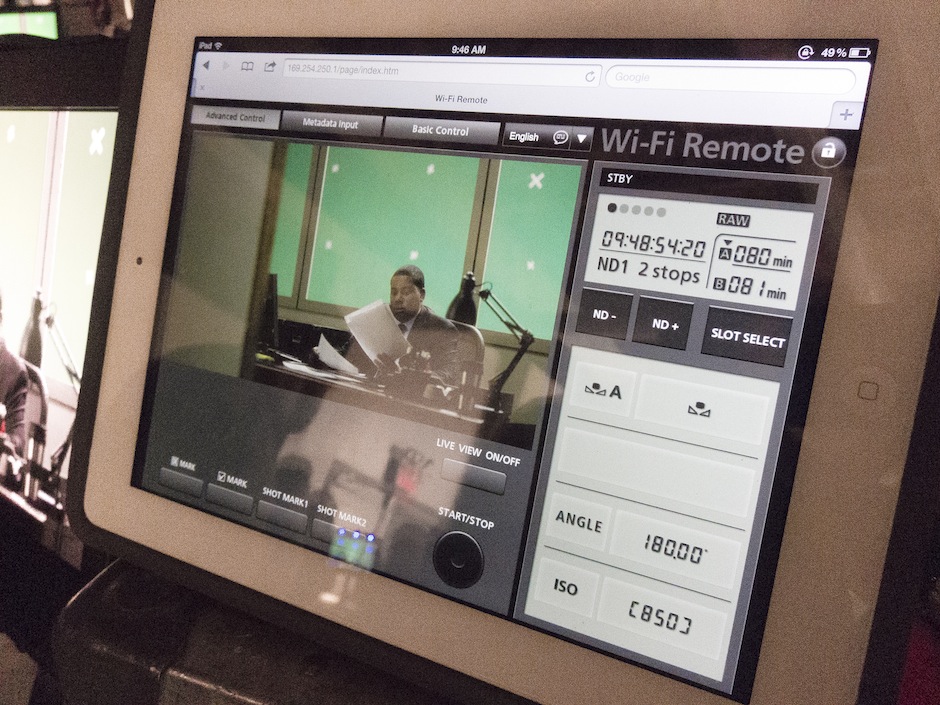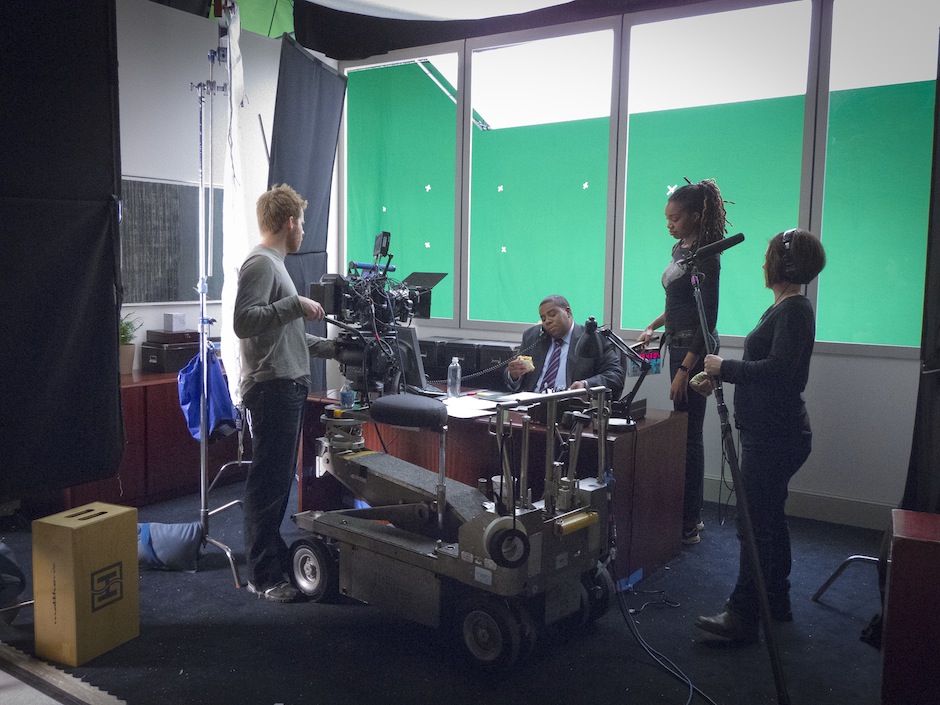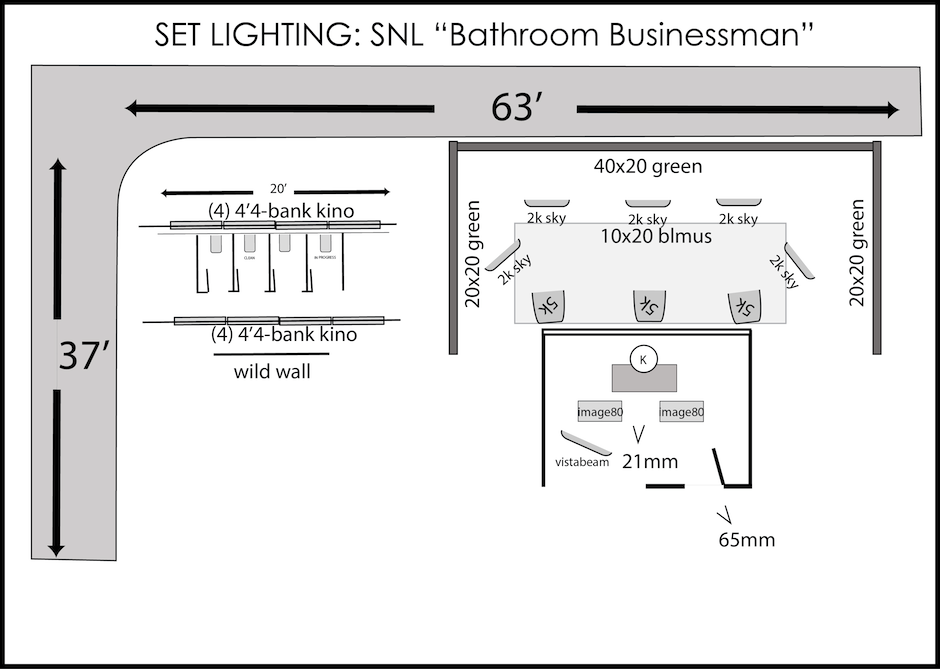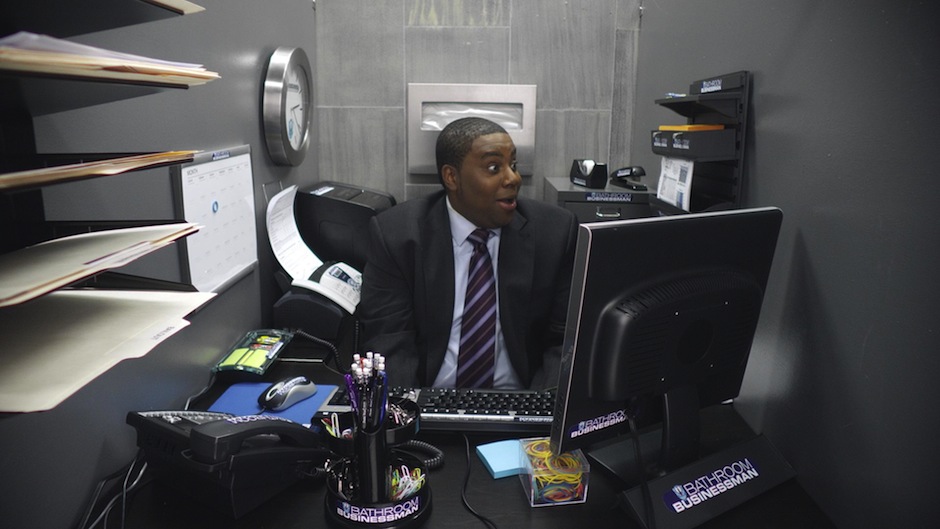This is the second post in a series I’m calling HOW WE DID IT. In my last post I described how the weekly schedule breaks down at SNL, the gist of which for us in the film unit is: Prep Thursday, Shoot Friday, Broadcast Saturday. In this post, I’m just going to cut to Wednesday night at around 7pm when I got the call that a script called “Bathroom Businessman” was greenlit.
In the script, written by Co-Head Writer Colin Jost, Keenan Thompson plays a workaholic executive who can’t stand wasting even a moment of time by taking a toilet break. Lucky for him, now there’s the “Bathroom Businessman” – a new product that turns any toilet stall into a multi-function office suite so that Keenan never has to miss a moment of work-time. (If you’ve seen the spot, you know there’s also a twist at the end that turns the absurd script into a perfectly observed commentary.) From a practical perspective, it seemed pretty straightforward: one actor (with a quick appearance by Nasim) in two locations – which sounded pretty do-able, even considering that we only had 2 days to produce it.
Since most of this script takes place inside a bathroom stall, my director, Rhys Thomas, decided right away that we’d have to build the stall on stage rather than try to shoot on location. A real stall is just too small and impractical; we needed to get a camera inside the stall, which meant pulling the stall apart. Once we pulled the trigger on a set build, we decided to build the office on stage, too. We could have shot the office on location, but finding an office with a nice view of the city and scheduling to shoot it at the right time of day for the view – not to mention dealing with changing light and weather – plus making a company move from a practical office to a stage within our single shoot day was never gonna happen…The one thing we decided to shoot on location was a few transition shots to sell the illusion that the office and bathrooms are real. So we found a nice bathroom within our building at 30 Rock for an establishing shot, along with an office corridor where we could establish Keenan walking from his office to the bathroom, and where he has a funny line of dialogue with his secretary, played by Nasim.
Bear in mind, these decisions all had to happen on Wednesday night so that our Art Director, Andrea Purcigliotti, could quickly design the sets for the set shop to start building first thing on Thursday morning. The sets would be loaded into the stage Thursday night, and that’s when Andrea and Production Manager Justus McLarty got to stay up all night with the rigging grips and scenics, making sure the sets are assembled, painted and ready by our 5:30am Call Time on Friday morning. You’d think that getting two large sets banged out in one day would be the big challenge but who knew: the hardest design element was finding the hardware to build the bathroom stalls! Andrea and our Set Decorator Ipek Celik spent most of the prep day scouring the city for stall fittings that would match our practical bathroom. That’s a great example of a challenge you just can’t anticipate when you read a script.
The office was designed with a large window about 16’ wide. One of the trickiest things about shooting a scene on stage with a large window is: what do we see outside the window? Sometimes we use translights – large photo-backdrops that we either front-light or backlight – but I think these rarely look convincing and with a 16’ window, the translight would have to be enormous to accommodate all the different angles of view within the room. It’s easy to make the mistake of thinking that a 20’x20’ backdrop will be large enough to cover a 16’ window, but you have to keep in mind that you need to back the drop away from the window in order to light it, and unless you’re only looking through the window from one angle, you’ll soon realize that you need something more like 40’ wide or more.
We’re also limited to whichever translights we can find available on our single prep day – which are often pretty limited and sadly dated. For that reason, I’ve become a big fan of shooting greenscreen outside windows and having our editor, Adam Epstein, composite the shot in post with hi-rez background plates that I often shoot myself. For this spot, I just stuck my 5DmII out the window at 30 Rock and shot a skyline plate that worked perfectly for outside our executive office.
On the camera side, we decided to shoot this spot with a Canon C500. We chose the C500 because we wanted to finish the spot in 4K for archival reasons, and we also thought that the smaller, lightweight camera body would make shooting inside the bathroom stalls a little easier. We’ve also found that the C500 has a very crisp look with exceptionally accurate color, which I thought would work well for this spot. The next question is: what kind of lenses to use? In the past, I often used Angenieux Optimo zooms for everything at SNL, since they’re beautiful lenses and allow us to move so quickly. But lately Rhys and I have become obsessed with the discipline of composing with prime lenses. Our go-to lenses this season have been the Leica Summilux-C primes and the Arri/Zeiss Master Primes. As a very broad rule of thumb, we use the Leicas when we need a warm cosmetic look and the Master Primes when we need a colder, harder look. Reasonable alternatives that I also like are the Cooke S4s for a warm look and Ultra Primes for a cold look.
For this spot, we chose Master Primes. I try to reduce the set to 5 or 6 lenses to keep a consistent look (and also since they’re so expensive to rent!). I normally go with traditional focal lengths: 18mm, 25mm, 35mm, 50mm, 75mm, 100mm. But for this one, we wanted to go with a wide-angle look so I went with: 16mm, 21mm, 27mm, 40mm, 65mm. I also grabbed the 100mm just to be safe.
My 1st AC, Nick Demas, surprised me with a new feature on the C500 build: the Canon WiFi Adapter (the official, very sexy name is the “WFT-E6A”). With this little device, Nick could interface with the camera via iPad, giving him control over start/stop, color temperature, ISO, shutter angle, etc. I’m always game for trying out a cool new device if it’s appropriate for the job, and in this case, the iPad controller came in handy because we decided to use a jib arm to get some high-angle shots over the bathroom stall so we needed the remote on/off control.

Since we were buildling the camera on a jib arm, it occurred to me that we could drop the lens inside the stall from above using a periscope lens, which could help us move even faster, because we could squeeze the lens inside the stall without having to remove any stall-walls – so we rented a Century Periscope 2000. I’ve used the T-Rex periscope on other jobs at SNL and it’s superior in many ways, but it comes with it’s own lenses and would not accommodate our Master Primes, so I decided against it.
Well, this whole “periscope idea” turned out to be a better hypothesis than a practical theory. We quickly discovered that maneuvering and stabilizing a long jib arm over the set with a periscope lens was way too complicated and time-consuming. We started falling behind on our schedule and had to punt: we pulled the camera off the jib, I threw it on my shoulder and we shot most of the spot handheld! This is a great lesson in keeping things simple – a lesson that I seem to keep forgetting and have to re-learn the hard way.
From a lighting perspective, I wanted to keep the spot soft and contrasty, with no hard light or shafts of sunlight. Our location bathroom that we were matching was very modern with a low-key, slate gray underlit vibe that reminded me of a David Fincher movie, so I decided to go with that kind of look. That probably sounds absurd for a commercial about a guy using a bathroom stall for an office but I try to give myself rules and keep a strong look in mind – even if I often don’t have the time to completely pull it off.
My Key Grip on this shoot was Archie Ciotti; he rigged a greenscreen semi-circle around the window-set that was 40’ wide by 20’ deep that my Gaffer, Sean Sheridan, lit with five 2K skypans. In the past I’ve used 5K skypans to light greenscreens, especially back in the 35mm filmstock days, but now that all these new cameras have such high native ISOs, I often find that 2K skypans are more than enough. I also used to light greenscreens to be AT KEY via reflected light meter, i.e. – if I’m shooting at a T2.8, the screen would read 2.8 reflected. However, with new digital cameras and compositing software, I’ve learned from my friends on the visual effects side that lighting a greenscreen to be a stop underexposed is better for everyone: the color is more saturated and also reflects less green spill all over the set.

We lit the office interior with three 5Ks bouncing into a 10’x20’ overhead bleached muslin outside the office window to look like skylight. I gelled with 1/8 CTB and 1/8 PlusGreen, to subtly look like it was being filtered through a highrise office window. Inside the office I hung a couple Image80 Kinos from the grid to toplight like natural fluorescent office light. For a soft key, I used a Kino VistaBeam600 through a 6’x6’ Full Grid, skirted to keep it off the walls. No fill light – I wanted to keep it contrasty and natural looking. One of the first problems I ran into was that the windows, which were fitted with 4’x8’ sheets of plexi, were reflecting my key light right back at the camera. The windows were so large that there was virtually no angle I could place my light to avoid the reflections. Yet I couldn’t pull the plexi out of the windows without pulling the entire set apart. So out came the skill saws as my grips literally cut the plexi out of the window frames. As a general rule – another one I seem to keep forgetting: if you’re shooting greenscreen plates, it’s a lot easier to build your set without glass/plexi in the windows. Your compositor can easily add a reflective opacity layer that looks like glass in post.
For the bathroom set, I rigged a row of 4’ 4-bank Kinos on a 20’ pipe mounted to rolling stands – a rig called a “goal post” – that I placed over the stalls. I had another goal post with Kinos out in front of the stalls. Finally, for our transition shots on location, I was trying out a new type of light from a company called Hive Lighting. We used their 2-Light “Killer Maxi” and their “Wasp Par”, and I thought they were amazing. The lights have a plasma source and a huge output while drawing almost no power and zero flicker at any frame rate. The 2-Light Maxi gave me the equivalent of a 1.2k HMI while only drawing about 4.5amps. Think about that for a second: you could plug four of these lights into a 20amp circuit and have nearly the equivalent output of a 6k HMI on house-power! The daylight-balanced light was incredibly clean and pleasing. The ballasts are also built into the light so you’re not dragging around extra ballasts and header cables. Very cool new instruments for location lighting when you need a lot of light but want to use house-power and avoid a generator / tie-in. A word of caution: these lights do not hot re-strike and require warm-up time similar to working with HMIs, yet during that time, they don’t strike at all, which can leave you anxious since nothing appears to be happening. I suggested to Hive that they consider adding an otherwise non-functioning green LED that turns on when you strike the light just to make us feel better!

I like pointing out the unsung heroes of a shoot and for this one, our Set Decorator Ipek and our Prop Department were the stars: Rob Ackerman, Paul Kineke, Giff Meyer and Vlada Joseph. For me, this spot works because the actual product is so well realized as a prop. Don’t get me wrong: I love getting so much credit when a spot looks great, but in truth, on the big reveal-shot/punchline, my contribution was a Kino Flo lighting the set from the top; everything else was the Art and Prop Departments, plus a very funny dude named Keenan.
No 4k-shoot description would be complete without addressing the challenge of a 4k workflow. The C500 records 1080 MPEG-2 internally to compact flash cards while outputting 4k in the Canon raw .RMF format through the SDI outputs to a third party external recorder. There are a few options for external recorders and I’ll cover my thoughts on them in my next post – which is a much longer discussion. The workflow for this job involved recording an edit-proxy to the internal compact flash cards while recording the raw 4k media to the Gemini 4:4:4 by Convergent Design. The raw files were sent to our colorist, Emery Wells at Katabatic, while the proxy files were sent to our editor, Adam Epstein. Adam and Rhys (our director) started cutting around 8pm and had a rough cut finished by about 2am, at which point they emailed the EDL to Emery, who then processed the raw footage (he technically “debayered” the raw footage) and output 4k ProRes, conforming the EDL on Saturday morning. Emery, Rhys and I spent Saturday afternoon emailing still frames back and forth, discussing the color correction. By around 6pm, Emery exported both a 4k ProRes version and a 1080 ProRes HQ version for broadcast, which went back to Adam on hard drive. Adam was meanwhile spending Saturday afternoon working on the greenscreen composites, adding sound fx, music and motion graphics. He then overcut the new colored footage back into his timeline. The final ProRes HQ version was output and delivered to the Live Show by 8pm, just in time for the Dress Rehearsal!
As I’ve stated before, this description only scratches the surface of what happens each week at SNL and I can only speak for my small role in the Film Unit. As for the real magic trick of how the Live Show comes together – I have no idea how they pull that off!
Once again, if you’re interested in learning A LOT MORE about how I like to work, check out my workshop tour this summer. It’s called the VISUAL STORYTELLING TOUR and I’ll be visiting 31 cities between June and July.

